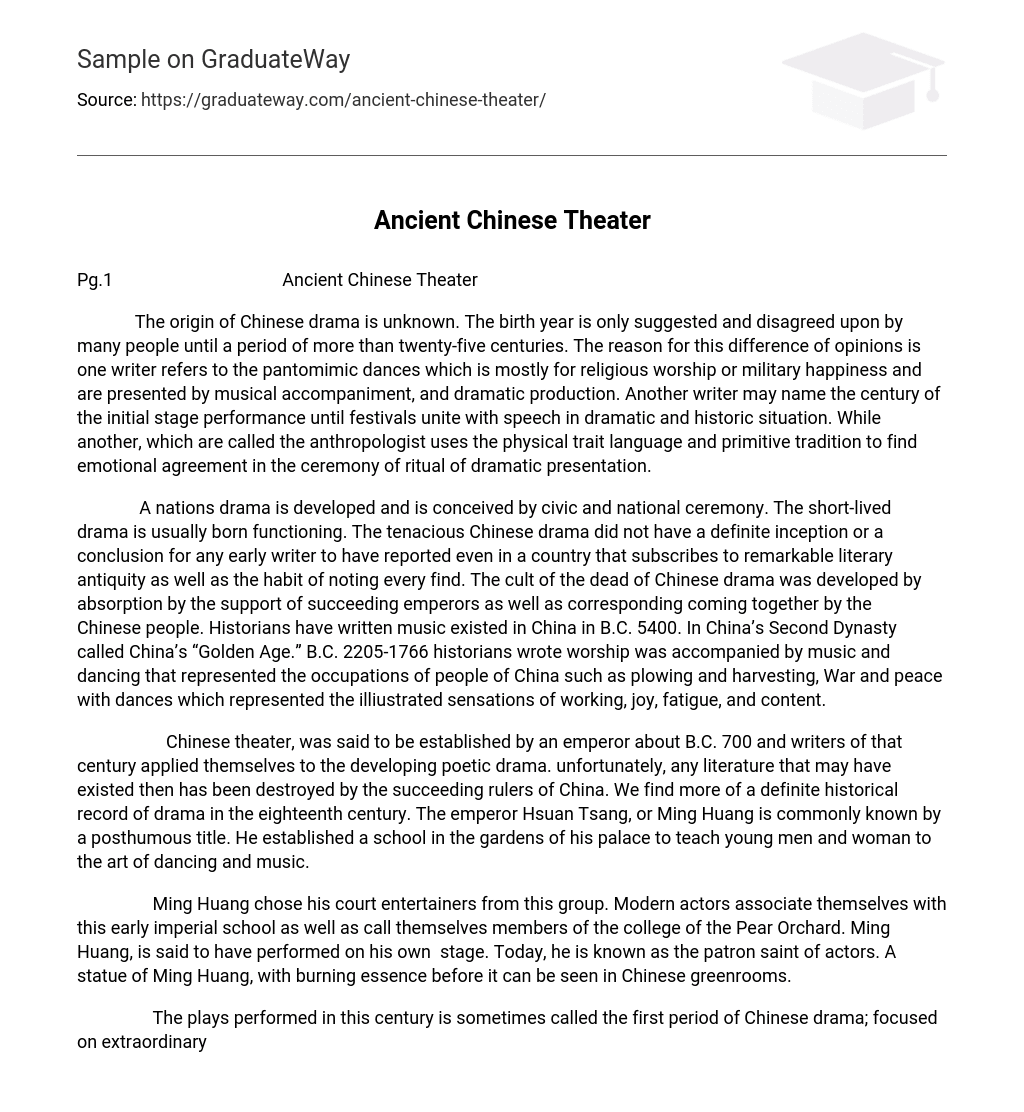Pg.1 Ancient Chinese Theater
The origin of Chinese drama is unknown. The birth year is only suggested and disagreed upon by many people until a period of more than twenty-five centuries. The reason for this difference of opinions is one writer refers to the pantomimic dances which is mostly for religious worship or military happiness and are presented by musical accompaniment, and dramatic production. Another writer may name the century of the initial stage performance until festivals unite with speech in dramatic and historic situation. While another, which are called the anthropologist uses the physical trait language and primitive tradition to find emotional agreement in the ceremony of ritual of dramatic presentation.
A nations drama is developed and is conceived by civic and national ceremony. The short-lived drama is usually born functioning. The tenacious Chinese drama did not have a definite inception or a conclusion for any early writer to have reported even in a country that subscribes to remarkable literary antiquity as well as the habit of noting every find. The cult of the dead of Chinese drama was developed by absorption by the support of succeeding emperors as well as corresponding coming together by the Chinese people. Historians have written music existed in China in B.C. 5400. In China’s Second Dynasty called China’s “Golden Age.” B.C. 2205-1766 historians wrote worship was accompanied by music and dancing that represented the occupations of people of China such as plowing and harvesting, War and peace with dances which represented the illiustrated sensations of working, joy, fatigue, and content.
Chinese theater, was said to be established by an emperor about B.C. 700 and writers of that century applied themselves to the developing poetic drama. unfortunately, any literature that may have existed then has been destroyed by the succeeding rulers of China. We find more of a definite historical record of drama in the eighteenth century. The emperor Hsuan Tsang, or Ming Huang is commonly known by a posthumous title. He established a school in the gardens of his palace to teach young men and woman to the art of dancing and music.
Ming Huang chose his court entertainers from this group. Modern actors associate themselves with this early imperial school as well as call themselves members of the college of the Pear Orchard. Ming Huang, is said to have performed on his own stage. Today, he is known as the patron saint of actors. A statue of Ming Huang, with burning essence before it can be seen in Chinese greenrooms.
The plays performed in this century is sometimes called the first period of Chinese drama; focused on extraordinary themes and inspired the present heroic drama.
The interest in the drama did not stretch further than the imperial court until the thirteenth century. As far as historians know, drama as it exits today in China appears to have fallen quietly into existence. Historian’s believe what happened in the thirteenth century was the diversions of subject and character were established which led to an enduring literature and theaters were produced.
Decoration, costume, and symbolic design is considered as an external of the drama. In China, it is a profound element in the dramatic performance through symbolism using seductive fantasy of form and color, which the symbolism lends itself.
Decoration and costumes is an essential part of China’s classical theatre which is performed on a stage with no scenery. The reason for no scenery, is explained by Chinese as their type of theater does not imitate landscape, or interior. It is the audience who suggests by emotion.
The use of scenery, to the Chinese is a silly unnecessary bother. The use of no scenery releases the imagination of the actors to act out every animal character, flower, fetish, and mountain where there is none. Action creates scenery. If a criminal is to be executed, the actor wails a confession of guilt and stands under a bamboo pole which a piece of cloth is tied. The actor simulates his strangulation by throwing his head back and looking up to heaven. Rivers, wall, temples, groves, couches, etc are represented by a bench or a screen.
Costumes are beautifully authentic and astonishing beautiful. The clothes used in today’s Chinese theater, may have been worn several centuries ago by mandarins and court officials, concubines, emperors and their wives. Chinese dress was designed for ceremonies. A cloak would hides any condition of spiritual or physical poverty presenting men to the world as they wished to appear. The traditional stage dress of even a begger silk coat of a gay checked design. It is tradition in the “barbarian’s dress to wear a bit of fur around his throat.
The actors faces are painted with red, black, white, green and gold which adds to the characterization. The effect without scenery is given by groups of painted figures dressed in stiff brocade of all colors, by the glitter of large jewels of gold and silver tissues, tufted plumes, and long pheasant feathers, which wave above glistening headdresses of golden swords that add to the memorable beauty and magnificence of Chinese theater.
-Works Cited-
WWW.theatrehistory.com/asian/chinese001.html; the origin of the Chinese theatre by Kate Buss New York: Jonathan Cape & Harrison Smith, 1922.pp 17-21.
WWW.theatrehistory.com/asian/chinese002.html; Decoration, costume, and symbolic design in Chinese theatre by Kate Buss New York: Jonathan Cape & Harrison
Smith, 1922.pp.73-86.
WWW.questia.com- The online encyclopedia. Asian drama; Encyclopedia article; The Columbia Encyclopedia, Sixth Edition, 2004.





